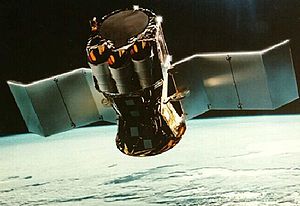- Submillimeter Wave Astronomy Satellite
-
SWAS 
SWASOrganización NASA Estado Inactivo Satélite de Tierra Fecha de lanzamiento 5 de diciembre de 1998 Vehículo de lanzamiento Pegasus XL Aplicación Observatorio espacial Masa 288 kg NSSDC ID 1998-071A Elementos orbitales Inclinación 69,9 grados Período orbital 96,8 minutos Apoastro 622,6 km Periastro 607,1 km Submillimeter Wave Astronomy Satellite (Satélite Astronómico de Ondas Submilimétricas) o SWAS, también denominado Explorer 74, es un observatorio espacial para realizar observaciones en el rango de las microondas. Fue lanzado el 6 de diciembre de 1998 desde Point Arguello mediante un cohete Pegasus.
Contenido
Objetivos
El objetivo principal de SWAS era realizar observaciones en el rango de 490 a 550 GHz para estudiar el enfriamento de los núcleos de nubes moleculares y estudiar los lugares de formación estelar de la Vía Láctea mediante la observación de las líneas características del oxígeno molecular y del agua.
Características
SWAS portaba un telescopio de 0,6 m de diámetro y un espectrómetro acusto-óptico.
El observatorio realizó observaciones hasta el 21 de julio de 2004, en que fue apagado. Fue reactivado en junio de 2005 durante tres meses para observar los efectos del impacto de la sonda Deep Impact con el cometa 9P/Tempel 1.
Referencias
Wade, Mark (2008). «SWAS» (en inglés). Consultado el 27 de junio de 2009.
- Este artículo fue creado a partir de la traducción del artículo Submillimeter Wave Astronomy Satellite de la Wikipedia en inglés, concretamente de esta versión, bajo licencia Creative Commons Atribución Compartir Igual 3.0 y GFDL.
Enlaces externos
Categorías:- Observatorios espaciales
- Programa Explorer
- Satélites artificiales lanzados en 1998
Wikimedia foundation. 2010.
